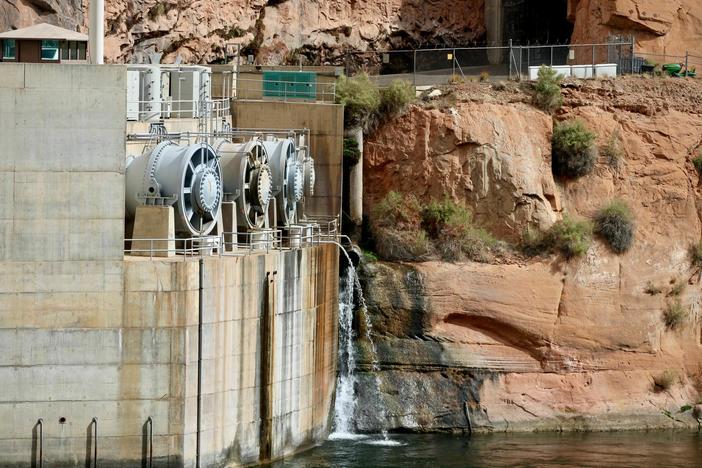Section Branding
Header Content
Home generator sales are booming with mass outages, climate change and COVID
Primary Content
Outside Christopher Glenn's house in the small Oregon community of Melrose, a white metal box sits next to the garage. The home standby generator was installed after a long outage in 2019.
"We had a major snowstorm that brought about 3 feet of snow to our backyard, and we were without electricity for approximately a week," says Glenn.
His spouse works remotely and couldn't work without electricity. They also own an organic tea business that was shut down by the outage.
"A customer in Ohio or Florida or Texas, they don't care if we're without power out here in Oregon. They want to know why we're not responding," says Glenn.
Beyond snowstorms, he's also concerned about outages during the wildfire season. As in California, Oregon utilities sometimes turn off electricity so power lines don't spark fires.
Around the U.S., climate change is bringing more intense and frequent extreme weather that often means mass power outages, including devastating, high-profile ones like that in Texas last year.
There's also concern about the reliability of an aging electrical grid at the same time as the grid is being decentralized and decarbonized with increasing amounts of renewable energy. And finally, there's the coronavirus pandemic, which has more people spending more time at home.
Industry experts say all this has created a boom in the number of Americans installing home generators. One manufacturer, Generac Power Systems, had a nearly 50% jump in revenue last year with sales of close to $3.7 billion, according to the company's president and CEO, Aaron Jagdfeld.
"That's off of a very strong set of years here. The company has grown dramatically. We're now approaching 10,000 employees," says Jagdfeld.
Buying a generator can be a big investment with a lot to consider. It's important to know what kind of generator would work best for your situation and how to use it safely.
Permanent models vs. portable
In Oregon, Glenn's model is on the higher end. The cost, including installation, was $9,000. But he says the next time the power goes out, he's prepared to keep the lights on and stay in business. The generator will power the house and an outbuilding where his tea business is located. It's big enough to also charge an electric car.
Jagdfeld says this is typical of Generac's customers, who mostly live in suburban, single-family, unattached houses. The generators Generac sells usually burn natural gas or propane.
But because home standby generators are expensive, they account for only about 5% of the market, says Paul Hope, home and garden editor at Consumer Reports. "The vast majority of generators run on gasoline and are different sizes of portable generators," he says.
Portable generators cost as little as a few hundred dollars, but they come with limits. Most won't power an entire house, like a permanently mounted model will, so you have to choose what gets plugged in during an outage.
Hope says these generators can be connected directly to a circuit breaker box. That requires an electrician and a device called a "transfer switch" that protects your electronics when the power comes back on. It also keeps electricity from your generator from going to power lines outside your house, where it can hurt utility workers.
Generators can be deadly, so using one properly is key
Without the transfer switch, you have to run extension cords from the generator to individual appliances. And that brings up a big safety issue: where the portable generator is located.
The U.S. Consumer Product Safety Commission (CPSC) estimates that about 70 people die each year from carbon monoxide poisoning from portable generators. The agency says the machine must be at least 20 feet from a house, with the exhaust directed away from the home and other buildings where people go. The CPSC says you should never operate a portable generator inside a home, garage, basement, crawl space or shed — or even on a porch.
Part of the problem, says Hope, is that a lot of people wait to buy portable generators at the last minute, when they need it. That may not leave time to make good decisions, such as thinking about safety tips.
He says one mistake a lot of people make is not having enough heavy-duty, outdoor-rated extension cords on hand to allow them to put the generator at least 20 feet from the house.
"So they naturally try to bring it a little bit closer, plug some things directly into the generator and use fewer cords that way," says Hope. That risks carbon monoxide poisoning, though Hope says most new generators have automatic shut-offs if carbon monoxide levels get too high.
You may want to store gasoline in case of an extended outage
Another thing to consider is how much gasoline needs to be stored to run a portable generator during an extended outage. Some burn up to 20 gallons of gas a day. Hope says to make sure to store gas in approved containers and add fuel stabilizer to boost the life of the gas up to two years. If you still haven't used it by then, you can burn the gas in your car.
There are more climate-friendly alternatives
If you're thinking about buying a home generator, Hope says another consideration is climate change. Generators are "actually horrible fossil fuel-burning polluters that, of course, contribute to man-made climate change." And that, he says, fuels the same severe weather events that result in widespread power outages.
A cleaner but more expensive option is installing solar panels and batteries on a house. Those will keep the power on, like a generator, but only as long as there's enough sun to charge the batteries.
There also are portable power stations that cost at least $1,000 and are limited in how much power they provide.
"You can power a laptop or charge a cellphone, but you're really not going to be powering, you know, your refrigerator or anything for any great length of time," says Hope.
On the plus side, these power stations use rechargeable batteries, so they're quiet. And since they don't burn gas, they can be used safely indoors.
Copyright 2022 NPR. To see more, visit https://www.npr.org.
Bottom Content





